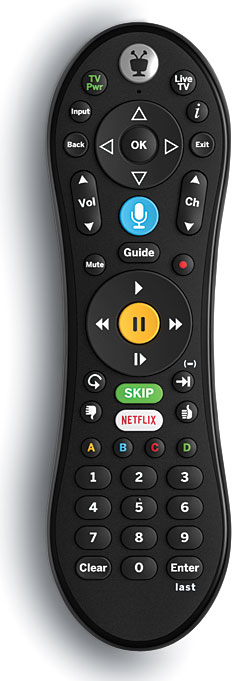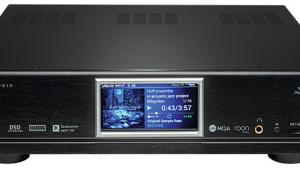TiVo Bolt Vox DVR and Streamer Review

AT A GLANCE
Plus
Voice-assisted search and channel changes
Skip button for vaulting commercials
QuickView feature
Minus
Voice control adds little to program navigation
New Experience interface is sometimes cluttered and confusing
THE VERDICT
Finding cable, streamed, and recorded content through the voice remote is much faster and more fun than using an onscreen keyboard. But the joined-at-the-hip New Experience interface may frustrate TiVo veterans until they get the hang of it.
With folks chatting up their smart speakers and smart TVs, TiVo owners may have felt like they were living in the silent era of cinema. Being behind the tech ball was especially galling for the TiVo community, which, not unlike the Apple fanbase, is willing to pay more for superior technology. In late 2017, TiVo, a name synonymous with the DVR, finally responded with a new remote and interface that recognize the value of voice recognition—especially when a viewer is searching for something to watch from among innumerable over-the-air, cable, streaming, and recorded-program options.
The TiVo Bolt Vox is the company’s first DVR to come with a listening remote. Physically, the Vox is identical to the TiVo Bolt Unified Entertainment System I reviewed previously (Sound & Vision, June 2016), including the stack-defying hump. It has the same roster of ports on the back panel and a CableCARD compartment underneath. However, the Vox is black, whereas the original Bolt was white.

The pricing structure for the Bolt Vox varies based on the tuner count and size of the internal hard drive. The most basic unit has four tuners and 500 gigabytes of storage for 75 HD hours of recording and costs $200. A four-tuner model with 1 terabyte storage good for 150 HD hours costs $300. The top line model boasts six cable-only tuners, has 3 TB for 450 HD hours, and costs $500. To any unit, you must add one of three service plans: $15 a month, $150 a year, or $550 for the lifetime of the device.
Preloaded on the Bolt Vox is an advanced onscreen interface called the New Experience. If you want to upgrade from an earlier TiVo model, the Vox remote (in black or white) is $40 for a Bolt or $45 for a Roamio. You must download the new interface and then pair the remote to the DVR. After TiVo assured me that features and performance would be the same, I chose to upgrade my existing Bolt for this review, mainly to avoid having to transfer my $5-a-month CableCARD. Pointing the new remote, I could control TiVo via RF and my A/V receiver’s volume via IR. The Bolt Vox has only one cable/antenna input, so you must choose between cable TV and broadcasting. Wi-Fi is built in, but connecting an Ethernet cable is recommended.
 The new TiVo remote retains the distinctive peanut shape but adds a blue button labeled with a white microphone icon. The traditional TiVo home button, designed as a TV with rabbit ears and feet (TiVo once gave away a plush-toy version), has been modified slightly to make room for the mic hole just below it. New, too, are a Netflix-launch button and a green Skip button for quelling commercials. (The tiny, multipurpose D button continues to work for skip, too.) Zoom is gone, and a few buttons have been moved.
The new TiVo remote retains the distinctive peanut shape but adds a blue button labeled with a white microphone icon. The traditional TiVo home button, designed as a TV with rabbit ears and feet (TiVo once gave away a plush-toy version), has been modified slightly to make room for the mic hole just below it. New, too, are a Netflix-launch button and a green Skip button for quelling commercials. (The tiny, multipurpose D button continues to work for skip, too.) Zoom is gone, and a few buttons have been moved.
Hearing Voices
By force of habit, I refuse to use superlatives like revolutionary. But I will say that searching for something to watch by speaking naturally versus slow-going through an onscreen keyboard is the difference between driving and walking. You can be specific, as in “Play Madam Secretary” or “Create OnePass for The Good Doctor.” You can be more general, as in “Show me Robert De Niro movies”—in which case, movie posters showing some 20 titles will appear. (You could refine this by adding, “Just comedies.”) You can say, “Show me Knicks basketball games,” and an array of NBA posters will appear, each designating an upcoming game.
Voice search performed surprisingly well, though there were a few times when I had to repeat myself because TiVo didn’t understand what I was asking. Note: You never start by saying a wake word like Alexa. You simply hold down the remote’s mic button until you complete your request. Your words will show up on the TV screen. Underneath, the program you’re watching will continue to play at normal volume but at a duller brightness.
I had a blast reciting famous quotes from movies. Such as: “Say hello to my little friend,” whereupon TiVo brought up Scarface and indicated whether I could record it from cable or rent or buy it from a streaming service. When I read lines from the American Film Institute’s 100 Greatest Movie Quotes of All Time, TiVo successfully identified the vast majority.
I loved the efficiency of being able to change channels by simply saying, for example, “HBO.” If I had remembered the number, I could have readily said “899” (HBO on my system) to achieve the same rapid result. If I said “Hulu,” the app would load. TiVo almost always responded accurately, and the result was direct tuning without necessarily having to scroll through a massive lineup.
Whereas deploying my voice paid off while I was searching for a program or changing channels, it added almost nothing to navigating within a program. TiVo didn’t recognize simple spoken commands like “pause” or “play” or more complex orders like “Go back 30 seconds” or “Jump ahead 20 minutes.” The only command that worked was “skip” or “skip it” to leapfrog commercials. But in that case, why bother moving your lips when, with the remote already in hand, you can simply press the green Skip button? At least that button doesn’t first make you swallow your chips and guacamole.






























































